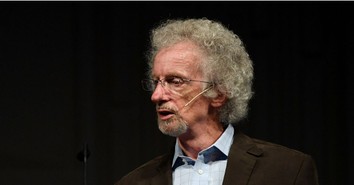How to Put Work Away at Home

The past two years have found many people working remotely, blurring the line between home and office. Gone are the days (if they ever truly existed) of coming home from one’s place of employment at the end of the day and leaving the work behind until arriving back at the office the following morning. Even before the pandemic, though, it had widely become a cultural norm to continue answering texts or checking email, or finishing a project after arriving home at the end of the traditional workday.
In John Mark Comer’s book The Ruthless Elimination of Hurry, he spends two chapters discussing the effect of busyness on our spiritual and mental health. He points out that “When the sun set our rhythms of work and rest, it did so under the control of God; but the clock is under the control of the employer, a far more demanding master.” He points out a shift in our attitudes regarding the use of time. “A century ago, the less you worked, the more status you had. Now it’s flipped: the more you sit around and relax, the less status you have.” In other words, our societal expectations have shifted to place a greater emphasis on the importance of productivity and prioritizing productivity over rest. Comer is far from the only voice declaring this shift a problem. A simple search of the internet or bookstore reveals a multitude of psychologists, pastors, tech gurus, and experts across a variety of fields declaring the dangers of hurry, busyness, overscheduling, and misplaced priorities. However, recognizing a problem is just the first step; we also need to do something about it.
Whether you’re working from home or the office, set work hours with clear boundaries. Communicate your intended start and end times to both colleagues and family, and invite them to hold you accountable. At the end of the workday, establish safeguards to ensure that you disengage from work. Create a routine to signal the end of the workday. If you’re commuting to and from your place of employment, use the trip home as a buffer. Perhaps that means making a list of the things you’ll need to tackle when you start work the following day so that your mind is clear of work when you arrive home, or maybe it’s listening to a podcast or music to get you out of work mode. If you’re working from home, creating an intentional buffer may be more challenging and also more important. Establish a habit like calling a friend or walking with a family member to mentally and physically end the workday.
This margin can be helpful on the front end of your day as well, especially if home is also your office. Think about how you’ll replace your morning commute rather than just jumping right into work. Try starting your day with a workout, Bible reading and prayer time, and preparing yourself a nutritious breakfast to fuel your day. If you are commuting, try using that time to pray over your day, colleagues, and tasks, and thank God for his provision, protection, and plans. It’s incredible what this intentional use of otherwise underused time can do for your day, especially if you work with difficult people or under stressful conditions.
Another important way to disengage at the end of the day is to turn off notifications. This can be quite challenging as we worry about missing something important. Granted, if you’re on call or have other circumstances requiring you to remain engaged, do so by all means. But if you don’t have to pay attention to texts or receive late calls, set yourself up for success. We are reliant on our phones for so many things that we often end up checking work emails or texts without making a conscious decision to do so. Think about turning your smartphone into a dumb phone (an idea from Comer’s book). There are several ways to do this, with varying degrees of commitment; for example, consider removing email from your phone (or at least your work email). Another idea to consider is setting boundaries on phone usage for yourself. Give your phone a “bedtime” and a “wake time” an hour or more before you go to bed and after you wake up. This may help you create a margin for yourself and enable you to establish some helpful buffer habits.
An important consideration as you set yourself up for success in putting away your work is to think about what you’ll do instead. One of the best ways to fail at behavior change is to focus on what you’re not going to do rather than being intentional with the actions you’ll take. Negative goals like this don’t work, both because they rely on your vigilance to avoid the old behavior (which may be such an ingrained habit that you don’t always realize you’re doing it) and also because you can only form new habits when you perform an action, not when you avoid one. Since you cannot create a habit to avoid an action, make a plan for what you’ll do when it’s time to stop working. Whether it’s some kind of personal development (take a class, go to the gym, etc.), a fun family activity, or a dedicated daily debrief with your spouse, find the thing that helps you stick to a hard stop for your work.
Even with a solid plan in place, there are likely to be times when work just won’t leave your mind. There are a couple of ways to respond to these thoughts that infringe on your off-time. One is to have a specific activity to occupy your mind when work creeps in. Do a crossword puzzle, read a book, try sudoku, really anything that will engage your mind. As an alternative, be ready for those moments when something pops into your head that you can’t shake by keeping a notebook handy (this is better than a notes app on your phone because grabbing your phone will increase the likelihood of engaging in a work activity). When a work issue comes to mind that really needs your attention, set a time limit (try to keep it short, maybe 5 minutes) and write down the thoughts, the project, the to-do list, the calls that need to be made; get whatever is occupying your mind out on paper and then move on.
Continuing the theme of setting yourself up for success, consider potential changes you might make to your environment. If you’re working from home, designate a specific work area and establish spaces where you will never work. This next suggestion may be jarring, but consider turning off your computer, tablet, and even your phone after work hours are over. Yes, shut the devices down all the way. If you have to boot up a device to check in on work, you’re less likely to give in to the temptation. Think about it this way; someone who wants to shift to a more nutritious diet isn’t going to leave cookies and chips in the pantry. Instead, they’ll remove junk food from the kitchen and stock up on healthy alternatives. Do the same kind of proactive planning for a shift in your time consumption as you would for your food consumption.
Perhaps the most helpful advice, though, is don’t go it alone. Include the people in both your personal and professional circles in this endeavor and enlist their support. Give your family permission to remind you to put your phone, computer, or tablet away - and then be thankful (as opposed to annoyed) when they do so. Get your boss and colleagues on board with your work hours as well. Sometimes, you may have to be flexible with a big project or a looming deadline, but make these scenarios the exception instead of the rule.
Set yourself up for success, and set yourself up for a much healthier, more enjoyable work/life balance. It may prove difficult at first, but it won’t be long before you establish new habits and begin to enjoy the boundaries you’ve set.
Photo credit: ©GettyImages/DrazenZigic

Originally published March 21, 2025.







